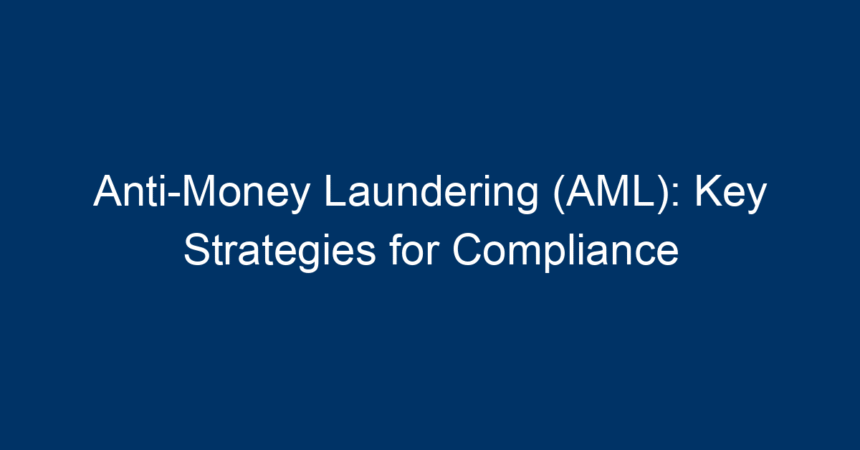Introduction
In the increasingly interconnected world of finance, the fight against money laundering is more crucial than ever. Anti-Money Laundering (AML) regulations are designed to protect financial systems from being exploited by criminal enterprises. Organizations of all sizes need to implement robust AML strategies to ensure compliance and safeguard their reputations. This article delves into the essential strategies for effective anti-money laundering compliance, offering actionable insights that can help businesses navigate the complexities of AML regulations.
Understanding Money Laundering
Before diving into strategies, it’s vital to understand what money laundering is. The process involves concealing the origins of illegally obtained money, typically through a series of transactions that make the funds appear legitimate. The three primary stages of money laundering are:
- Placement: Introducing illicit funds into the financial system.
- Layering: Conducting complex transactions to obscure the source of the funds.
- Integration: Reintroducing the laundered money into the legitimate economy.
The Importance of Anti-Money Laundering (AML) Compliance
Organizations that fail to comply with AML regulations risk facing severe penalties, including fines and reputational damage. Compliance is not just a regulatory obligation; it’s essential for maintaining customer trust and financial integrity. According to the Financial Action Task Force (FATF), effective AML measures can significantly reduce the risk of financial exploitation and bolster the overall health of the global economy.
Key AML Strategies for Compliance
1. Develop a Comprehensive AML Policy
Creating a well-structured anti-money laundering (AML) policy is the cornerstone of compliance. This policy should include:
- Scope of the Policy: Outline the areas covered and the types of transactions monitored.
- Objectives: Define the goals of the AML program, such as risk mitigation and regulatory compliance.
- Roles and Responsibilities: Clearly delineate who is responsible for AML compliance within the organization.
A comprehensive AML policy must be regularly updated to adapt to changing regulatory requirements and emerging money laundering tactics.
2. Conduct a Risk Assessment
Risk assessments are fundamental to understanding vulnerabilities in an organization’s operations. This process involves identifying potential risks associated with:
- Customer Profile: Who the customers are and their geographical locations.
- Types of Products and Services: What financial products or services are offered that may attract illicit activity.
- Transaction Patterns: Analyzing historic transaction data to identify unusual or suspicious patterns.
Regular risk assessments will help tailor the AML strategy to meet specific organizational needs, ensuring that resources are allocated where they are most needed.
3. Implement Know Your Customer (KYC) Procedures
KYC procedures are vital to AML compliance. By verifying the identity of customers, organizations can prevent access to financial services by high-risk individuals. Key components include:
- Customer Identification: Collecting and verifying identification documents.
- Customer Due Diligence (CDD): This involves assessing the risk associated with customers and monitoring their transactions accordingly.
- Enhanced Due Diligence (EDD): For high-risk customers, more thorough investigations are required.
KYC not only assists in AML compliance but also enhances customer relationships by promoting transparency.
4. Develop a Robust Transaction Monitoring System
A transaction monitoring system (TMS) is a crucial aspect of an effective AML program. This system enables organizations to:
- Identify Suspicious Activity: Set parameters and alerts for potentially illicit transactions based on established risk indicators.
- Generate Reports: Create comprehensive reports for internal audits and regulatory submissions.
- Adapt and Update: Continuously adjust the system based on emerging trends and regulatory changes.
Automating transaction monitoring can help organizations detect anomalies in real-time, mitigating the risk of money laundering effectively.
5. Training and Awareness Programs
An informed workforce is essential for maintaining compliance. Regular training sessions should cover:
- AML Regulations: Educating employees about the legal requirements of AML compliance.
- Red Flags: Identifying common signs of money laundering and suspicious behavior.
- Reporting Protocols: Encouraging employees to report any suspicious activity without fear of retaliation.
By fostering a culture of compliance, organizations can better protect themselves against financial crime.
6. Establish Effective Reporting Mechanisms
Organizations must have secure and efficient reporting mechanisms for suspicious activities. This includes:
- Suspicious Activity Reports (SARs): Guidelines for filing SARs with relevant authorities when suspicious transactions are identified.
- Internal Reporting Procedures: Clear channels for employees to escalate concerns without confusion.
- Feedback Loops: Mechanisms to review and improve reporting processes based on lessons learned from past incidents.
Effective reporting can facilitate timely interventions and contribute to broader AML initiatives.
7. Leverage Technology and Data Analytics
The integration of advanced technology can significantly enhance an organization’s AML efforts. Key technologies include:
- Artificial Intelligence (AI): AI can analyze vast amounts of data to identify unusual patterns indicative of money laundering.
- Machine Learning: These algorithms can adapt and improve over time, making the transaction monitoring process more efficient.
- Blockchain Analysis: In cryptocurrency transactions, blockchain analysis tools can help track the flow of funds and detect anomalies.
Adopting these technologies not only enhances compliance but can also lead to substantial cost savings.
8. Collaborate with Regulatory Authorities
Building a collaborative relationship with regulatory bodies enhances AML compliance. Regular participation in industry forums and consultations can help organizations:
- Stay Informed: Keep abreast of changes in regulations and best practices.
- Share Insights: Exchange information with peers about challenges and effective strategies.
- Engage in Dialogue: Communicate proactively with regulators about compliance efforts and seek guidance when needed.
Collaboration fosters a proactive approach to compliance and enhances overall industry integrity.
Conclusion
Implementing effective anti-money laundering (AML) strategies is essential for organizations aiming to comply with regulatory requirements and protect against financial crimes. By developing a comprehensive AML policy, conducting thorough risk assessments, and leveraging technology, businesses can enhance their defenses against money laundering.
Training employees, establishing clear reporting mechanisms, and collaborating with regulatory authorities further strengthen these efforts. By adopting these practical strategies, organizations can foster a culture of compliance that not only mitigates risk but also boosts customer confidence and business reputation.
Actionable Insights and Next Steps
- Assess Your Current AML Policy: Review and update your existing AML framework to ensure comprehensive coverage.
- Invest in Technology: Explore advanced solutions for transaction monitoring and customer verification.
- Engage Your Workforce: Launch or refresh training programs on AML compliance and risk awareness.
- Network with Peers: Participate in industry forums to share knowledge and best practices.
By taking these steps, organizations can not only strive for compliance but also play a pivotal role in safeguarding the financial ecosystem from the dangers of money laundering.




